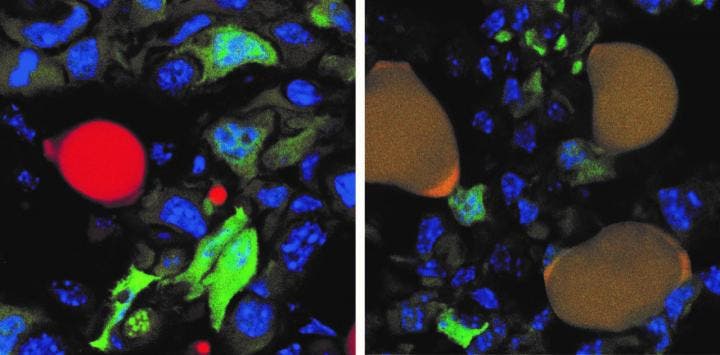The treatment not only stopped cancer cells from spreading but also transformed them into harmless fat cells.

The image above depicts this process. The cancer cells are tagged with a green fluorescent protein; a normal red fat cell is on the left. The cancer-turned-fat cells are display as brown on the right (from the red of the fat cells and the green of the protein cancer cell tag combined). Image credits: Department of Biomedicine, University of Basel / Cell Press.
In recent years, it’s become increasingly clear that cancer is not one single condition — it can manifest itself in several forms. Therefore, it makes a lot of sense that there’s not one single bullet to deal with it, but rather a multitude of different solutions and approaches. This has yielded a slow success, as overall cancer fatalities have declined by 25% in the past 25 years or so, and the slow and steady decline continues today.
In a new study, researchers demonstrated an intriguing approach that essentially turns cancerous cells into fat. They took advantage of a critical phase that metastasizing cancer cells go through. The process is called epithelial-mesenchymal transition (EMT) — and it’s the opposite of the mesenchymal‐to‐epithelial transition (MET), a much more familiar process that happens when you cut your finger. During MET, the skin cells start to look less like themselves, as they turn into a type of stem cell called “mesenchyme” and then become whatever cells the body needs. Cancer cells do the opposite of this to spread throughout the body, but they’re vulnerable during this very specific moment.
So researchers took mice implanted with an aggressive form of human breast cancer, and treated them with a cocktail of two drugs: a diabetic drug called rosiglitazone and a cancer treatment called trametinib. Not only did this stop the cancer spread, but it also turned a hefty part of them into fat.
“Adipogenic differentiation therapy with a combination of rosiglitazone and [trametinib] efficiently inhibits cancer cell invasion, dissemination, and metastasis formation in various preclinical mouse models of breast cancer,” the team writes.
Not all the cancer cells turned into fat, however, but the ones that did remained as fat cells.
“The breast cancer cells that underwent an EMT not only differentiated into fat cells, but also completely stopped proliferating,” says first author Gerhard Christofori, professor of biochemistry at the University of Basel. What’s more, the primary tumor did not metastasize. “As far as we can tell from long-term culture experiments, the cancer cells-turned-fat cells remain fat cells and do not revert back to breast cancer cells,” he says.
Despite this being a study on mice (and most of these studies don’t translate on humans), there is a very good reason to be optimistic: the two drugs in the study are already approved for treatment. So it’s possible for clinical trials to start relatively soon, researchers conclude.
The study was published in Cell.









